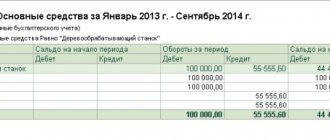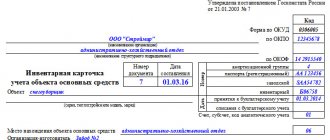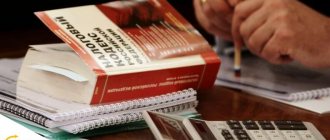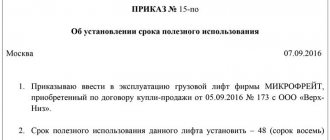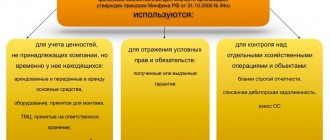When new material assets begin to operate at an enterprise, their receipt must be properly documented, since the value of property assets added to the balance sheet directly affects many other production factors. The procedure for capitalization of fixed assets must comply with regulatory requirements, be documented and be correctly recorded in accounting accounts.
Let's consider the ways in which fixed property assets can reach an enterprise, how to correctly carry them out according to the accounting procedure, and in what documents to display them.
Primary documents - grounds for accounting for introduced fixed assets
No property asset can appear in an enterprise “out of nowhere”: its introduction is necessarily accompanied by a number of documentary evidence. Based on the primary documentation corresponding to a specific group of production assets, each object or their group is registered on the balance sheet. Depending on whether they belong to a group of objects, the introduction of an asset may be accompanied by the following “primary”:
- acceptance certificate - for the acceptance of various objects, a certain form is provided (OS-1a - provided for structures and buildings; OS-1 - for other single objects; OS-1b - for groups of fixed assets, excluding structures and buildings);
- invoice (act) for acceptance of equipment - for equipment that does not require preliminary installation (form OS-14);
- act (invoice) of acceptance and transfer of equipment for the purpose of carrying out installation work - form OS-15.
For each new object from the fixed assets put into operation, it is necessary to create a special inventory card according to the established model:
- for a single OS object - according to the OS-6 form;
- for several grouped objects - according to the OS-6a form.
In it, the asset is assigned a unique inventory number , constant for the entire life of the asset (usually this is a serial number in a certain series).
These cards will subsequently reflect the entire “life” of the main asset in the enterprise:
- admission;
- depreciation;
- revaluation;
- modernization;
- conservation-depreservation;
- recovery;
- disposal (write-off).
The results are compiled into a single inventory book , where the final accounting of fixed assets is carried out, which must be drawn up in the OS-6b form.
statement of the dynamics of fixed assets is compiled using inventory cards .
Documentation for receiving OS
Currently, documentation of fixed assets received by the company does not have to be carried out using standardized forms. Firms have the right to use forms developed independently. However, in practice, unified forms are still actively used.
When the OS arrives at the company, a transfer and acceptance certificate of the OS is drawn up in the form:
- OS-1 – for acceptance of all objects except buildings;
- OS-1a – for acceptance of buildings;
- OS-1b – for accepting groups of objects.
Acts according to these forms are drawn up on OS received by the company:
- By purchase;
- Under contracts of exchange, purchase and sale and donation;
- By manufacturing for personal use.
When accepting special equipment, an act in form OS-14 is applied. If there is a need for the installation of special equipment, an OS-15 form is drawn up. If during installation it is discovered that the object is unsuitable for further use, fill out the OS-16 form.
Primary cost of OS
These accounting documents must include the primary cost of fixed production assets; it consists of the costs that the enterprise actually incurred for:
- acquisition;
- delivery;
- installation;
- construction;
- acquisition of raw materials for creation;
- payment of state duty to obtain a license, etc.
IMPORTANT! The primary cost of received fixed assets does not include the amount of VAT and other fees subject to reimbursement.
Registration of write-off of fixed assets
Registration of write-off of fixed assets is documented in acts of write-off:
- Form No. OS-$4$ – write-off of individual fixed assets;
- Form No. OS-$4$a – write-off of vehicles;
- Form No. OS-$4$6 – write-off of a group of fixed assets.
They are drawn up in two copies, signed by members of the commission appointed by the head of the organization, and approved by the head. The first copy goes to the accounting department, the second remains with the person responsible for safety. The document is the basis for delivery to the warehouse, sale of valuables, scrap metal remaining after write-off. When a vehicle is written off, a document confirming deregistration with the State Traffic Inspectorate is sent to the accounting department.
The initial and residual value, the amount of accrued depreciation, information about the costs of liquidating the object, and the receipt of material assets from write-off are indicated.
Accounting depending on the methods of receipt of fixed assets
Accounting for each fixed asset occurs differently; the method depends on the official source from where the fixed asset came to the enterprise. Different paths not only lead to different initial costs, but also different accounting nuances.
- Purchasing from a supplier. It is necessary to take into account all costs, including transport and installation, excluding VAT. According to accounting, this will be done in this way:
- the cost of the acquired asset excluding VAT (debit 08, credit 60);
- additional costs for delivery, installation, setup, etc. (debit 08, credit 60 or 76);
- allocation of VAT (debit 19, credit 60 or 76);
- putting the main asset into operation (debit 01, credit 08).
- Acceptance under a gift agreement. It is necessary to take into account the market price of the object, current at the time of donation (the amount must be documented).
ATTENTION! Entrepreneurs and organizations cannot make “gifts” to each other in amounts exceeding 5 minimum wages.Accounting entries:
- D08 K98/2 - the main asset was received free of charge and accepted for accounting;
D01 K08 - this material asset is put into operation;
- D98/2 K91 - writing off depreciation from account 98 to “other income”.
- Contributing your share to the authorized capital. The cost of the OS is agreed upon by the founders and regulated in the constituent documents.
NOTE! If funds are deposited for a significant amount exceeding 200 times the minimum wage, then it must be additionally assessed by an independent specialist.Accounting data:
- the property asset is introduced as a contribution to the authorized capital (debit 08, credit 75);
the main asset is put into operation (debit 01, credit 08).
- Creating an OS in-house (economic method, construction, etc.) - all costs for raw materials, the work itself (if necessary, then under contracts), transportation costs, installation, etc. are subject to accounting. Accounting:
- wages for contractors (debit 08, credit 60 or 76);
- cost of raw materials (debit 08, credit 10);
- all other costs incurred in creating the operating system (debit 08, credit 60 or 23, 25, 26, 76);
- allocation of VAT for all types of expenses (debit 19, credit 60 or 23, 25, 26, 76);
- putting a new asset into operation (debit 01, credit 08).
- Receipt under contracts where the remuneration provides for obligations other than monetary – the cost is determined in the same way as when transferring an object as a gift (based on the current market price for similar goods or services). Accounting entry:
- acceptance of funds for accounting (debit 01, credit 08);
- the asset is accounted for and put into operation (debit 01, credit 08).
Moving OS within the company
After the object has been accepted for accounting, an inventory accounting card is created for it (according to the OS-6 or OS-6a form). It describes all movements of the fixed assets: repair, liquidation, completion, reconstruction, and so on. All these transactions must also be reflected in the inventory book using the OS-6b form.
If an asset is moved between departments, an invoice must be issued for it in the OS-2 form. This document is drawn up in 3 copies. Responsible employees of the departments of the deliverer and recipient must put their signatures on it.
When repairing, reconstructing or modernizing a facility, an act of form OS-3 is generated. It contains all the data on the costs of performing the work. It is signed by the director of the organization and all members of the commission. If the work was carried out by a third-party company, the act is drawn up in 2 copies.
Unaccounted for fixed assets
Periodically, all enterprises carry out an inventory - an additional, intermediate accounting of all property assets. Sometimes the result of an inventory may be the discovery of one or more fixed assets that were not previously registered.
Such funds are subject to mandatory capitalization.
To do this, you need to find out their market value, which will be valid at the time of discovery (this moment will determine the date of entry on the balance sheet). Accounting should be made on the account “Fixed Assets” (debit 01, credit 91).
Forms of documents for registration of transactions with fixed assets
Documentation of transactions with fixed assets can be divided into two types of documents:
1. Documents that are used to document not only transactions with fixed assets.
This type of document includes:
– invoices or invoices used to document the purchase or sale of fixed assets; – acts of acceptance and transfer, which formalize fixed assets transferred for rent, authorized capital, etc.; – acts of provision of services (transport for the delivery of fixed assets, intermediary in the acquisition, etc.). – checks (payment of commissions, customs duties upon purchase/sale of fixed assets).
2. Documents used to document only transactions with fixed assets.
These documents, as a rule, are used in a unified form, but in some cases, such unified forms are somewhat transformed. Thus, the unified forms for fixed assets are the following:
– OS-1, form code according to OKUD 0306001 – Certificate (invoice) of acceptance and transfer of fixed assets. The purpose of this form is to register the fact of acceptance and transfer of a fixed asset object with the signatures of both parties, as well as a commission that confirms the technical condition of the object. – OS-3, form code according to OKUD 0306002 – Acceptance certificate for repaired, reconstructed and modernized fixed assets. This form is filled out if the fixed asset item was transferred for repair. This form reflects the results of repairs, modernization or reconstruction. – OS-4, form code according to OKUD 0306003 – Certificate of write-off of fixed assets. When disposing of an item of fixed assets, this form is filled out, which reflects the residual value of fixed assets and the results of disposal. – OS-14, form code according to OKUD 0306006 – Equipment acceptance certificate. This form is used when equipment arrives at the warehouse for the purpose of its subsequent use as an item of fixed assets. – OS-6, form code according to OKUD 0306005 – Inventory card for accounting of fixed assets. This form of document is created for each fixed asset object, which reflects all the characteristics and movements of the object. – OS-15, form code according to OKUD 0306007 – Certificate of acceptance and transfer of equipment for installation. This form of document is used if a fixed asset requires additional installation. – OS-16, form code according to OKUD 0306008 – Report on identified equipment defects. This form of documents is used to reflect defects identified during the transfer of fixed assets for installation.
Based on the above forms, the enterprise maintains continuous records of all business transactions regarding the movement of fixed assets.
3. Fixed asset accounting registers.
Fixed asset accounting registers can be: – cumulative registers for homogeneous types of equipment; – inventory lists of fixed assets by responsibility centers (workshops, sections); – summary statements on the formation of the initial cost; - etc.
We formalize the disposal of fixed assets
The act of write-off of fixed assets in the form OS-4 (OS-4b - for group write-off) accompanies cases of write-off of fixed assets that are out of order and cannot be repaired.
This form must be drawn up in 2 copies, signed by the head and a specially convened commission. The 1st copy of the document is given to the accounting department, the 2nd remains with the MOL and serves as the basis for the delivery of inventory items remaining as a result of dismantling (disassembling) the OS to the warehouse.
In case of disposal of a vehicle, it is necessary to submit a document to the accounting department that will confirm deregistration with the traffic police. To register such a write-off of an asset, you should use a form in the OS-4a form.
Find the forms required for write-off in the materials:
- “Unified form No. OS-4 - act on decommissioning of an asset”;
- “Unified form No. OS-4a - form and sample”;
- “Unified form No. OS-4b - form and sample”.
In the case of the sale of an asset, just as in the case of a purchase, a transfer and acceptance certificate in the OS-1 form is used. This document must be signed by the commission and the head of the company. Each organization (receiving and transferring parties) has its own page for filling out OS credentials.
You can view the step-by-step algorithm for deregistering an operating system in ConsultantPlus by receiving free trial access to the system.
Accounting for the receipt of fixed assets (purchase, donation, contribution, creation)
Now let's talk about how the OS arrives at the enterprise. There are several ways:
Accounting for receipt of fixed assets upon purchase
We will take into account the fixed assets at the initial cost, which will consist of all actual costs of acquisition and installation, transportation costs minus VAT. At the same time, we make the following entries in accounting. Postings when purchasing fixed assets for a fee:
Debit Credit Operation name 08 60 The cost of the purchased OS is taken into account (excluding VAT) 08 60 (76) The costs of transportation and installation of the OS are taken into account 19 60 (76) VAT on fixed assets allocated 01 08 OS commissioning Accounting for receipt of fixed assets upon donation
When received free of charge, the object is taken into account based on the current market price on the date of acceptance. Moreover, this market value must be confirmed by relevant documents that are attached to the acceptance certificate.
I would like to note that there is a limitation: gifts between commercial organizations are permissible only within 5 minimum wages.
Postings upon receipt of fixed assets as a result of gratuitous receipt:
D08 K98/2 – the gratuitously received object was accepted for accounting.
D01 K08 – the facility was put into operation.
Monthly depreciation will be written off from account 98 to other income using posting D98/2 K91 .
Accounting for the receipt of fixed assets when contributing to the authorized capital
When contributing a fixed asset to the authorized capital, the founders jointly agree on the cost at which the object will be accepted for accounting and write it down in the constituent documents. It should be noted that if the cost exceeds 200 minimum wages, then an independent assessment is required.
Accounting entries upon receipt of fixed assets in the form of a contribution to the authorized capital:
| Debit | Credit | Operation name |
| 08 | 75 | Receipt of fixed assets in the form of a contribution to the authorized capital |
| 01 | 08 | OS commissioning |
Accounting for receipt of fixed assets during construction
During construction, an object is accounted for at its cost, which consists of all costs associated with the purchase of materials for construction, transportation and contract work.
Accounting entries during OS construction:
| Debit | Credit | Operation name |
| 08 | 60 (76) | The cost of contractors' work is taken into account |
| 08 | 10 | Materials transferred to the contractor for the construction of the OS were taken into account |
| 08 | 60 (76, 23, 25, 26) | Other costs associated with the construction of the OS are taken into account |
| 19 | 60 (76, 23, 25, 26) | VAT is allocated on all costs associated with the construction of the OS |
| 01 | 08 | OS commissioning |
What to do after you have accepted an asset for accounting? Starting from the next month (from the 1st day), depreciation must be calculated. What is it and how to calculate it, we will understand further.
Download
sample forms for accounting for fixed assets at an enterprise: Form OS-1. Filling out the act of acceptance and transfer of fixed assetsForm OS-1a. Filling out the building acceptance certificateForm OS-2. Invoice for internal movement of fixed assets Form OS-3. Certificate of acceptance and delivery of fixed assets after repair Form OS-4. We fill out the act on write-off of fixed assetsForm OS-4A. Vehicle write-off certificate Form OS-6. Inventory cardForm OS-6B. Inventory bookForm OS-14. Certificate of acceptance and transfer of equipmentForm OS-15. Certificate of acceptance and transfer of equipment for installationForm OS-16. Defective act Order to write off fixed assets Disposal of fixed assets (entries, examples) Accounting for lease of fixed assets (entries, examples) Methods for calculating depreciation of fixed assets
Primary documents for asset accounting
⇐ PreviousPage 2 of 2
All households operations related to the movement of fixed assets are documented using standard forms of primary accounting documentation, approved. Resolution of the State Statistics Committee of the Russian Federation dated January 21, 2003 No. 7 “On approval of unified forms of primary accounting documentation for asset accounting.”
Act on acceptance and transfer of fixed assets (except for buildings, structures) f. No. OS-1 - the receipt and disposal of fixed assets is registered.
Act on acceptance and transfer of building (structure) f. No. OS-1a - receipt and disposal of buildings and structures is registered.
Act on acceptance and transfer of groups of fixed assets (except buildings, structures) f. No. OS-1b - receipt, disposal and internal movement of groups of the same type of fixed assets are recorded.
Invoice for internal movement of fixed assets f. No. OS-2 - internal movement of fixed assets is documented - from warehouse to workshop, from workshop to workshop.
Certificate of acceptance and delivery of repaired, reconstructed, modernized fixed assets f. No. OS-3 - operations on transfer for repair and acceptance from repair of the OS are formalized.
Act on write-off of fixed assets (except for vehicles) f. No. OS-4 – operations to write off fixed assets are formalized upon their liquidation.
Act on write-off of motor vehicles f. No. OS-4a - write off the write-off of vehicles.
Act on the write-off of groups of fixed assets (except for vehicles) f. No. OS-4b - write-off of groups of similar objects is formalized .
Inventory card for recording a fixed asset item f. No. OS-6 - drawn up on the basis of primary documents (transfer and acceptance certificates, technical passports, etc.) for each inventory number in one copy.
Inventory card for group accounting of fixed assets f. No. OS-6a - used for group accounting of similar items that have the same technical characteristics, the same cost, the same production and economic purpose and which entered service in the same calendar month.
On the front side of the inventory cards indicate the name and inventory number of the object, the year of manufacture (construction), the date and number of the acceptance certificate, location, initial cost, depreciation rate, cost code (for attributing depreciation amounts), the amount of accrued depreciation, internal movement and reason for departure.
On the reverse side of the inventory cards indicate information about the date and costs of completion, additional equipment, reconstruction and modernization of the facility, repair work performed, as well as a brief individual description of the facility.
Inventory book for accounting of fixed assets f. No. OS-6b - used when there is a small number of operating systems in the enterprise.
Certificate of acceptance (receipt) of equipment f. No. OS-14 – the receipt of equipment intended for capital construction is processed.
Certificate of acceptance and transfer of equipment for installation f. No. OS-15 – the delivery of equipment requiring installation for installation is formalized.
Report on identified equipment defects f. No. OS-16 - compiled for equipment defects identified during installation, commissioning or testing, as well as based on inspection results. On its basis, complaints to suppliers are drawn up.
Depreciation of fixed assets
Depreciation is the distribution of the cost of fixed assets over reporting periods during the joint venture and its repayment by writing off production or distribution costs, i.e. the process of gradually transferring the cost of fixed assets to manufactured products (works, services). The amounts transferred to the costs of the reporting period are called depreciation charges.
Depreciation is not charged for:
- OS objects whose consumer properties do not change over time (land plots; environmental management objects; objects classified as museum objects and museum collections, etc.).
— housing facilities (if they are not used to generate income)
— external improvement objects and other similar road facilities
- productive livestock
— perennial plantings that have not reached operational age
— mothballed OS objects.
During the reporting year, depreciation on fixed assets is accrued monthly in the amount of 1/12 of the annual amount, regardless of the results of the organization’s economic activities in the reporting period.
Accruals begin on the 1st day of the month following the month of acceptance of this object for accounting, and stop on the 1st day of the month following the month of full repayment of the cost of the object or its write-off.
The annual amount of depreciation charges is determined in one of the following ways:
1. linear method - based on the initial (replacement) cost of the object and the depreciation rate calculated on the basis of the SPI of this object.
Na = 100% / T, Ar = PS * Na or Na = PS / SPI
Example 1.
The company purchased a photocopier. His PS = 50,000 rubles, SPI - 5 years.
| Year | PS | Calculation A | Accrued A | Residual Art. |
| 50000 / 5 | ||||
| 50000 / 5 | ||||
| 50000 / 5 | ||||
| 50000 / 5 | ||||
| 50000 / 5 | — |
2. reducing balance method - based on the residual value of the fixed asset at the beginning of the reporting year and the depreciation rate calculated based on the SPI of this object and the acceleration factor (not higher than 3) established by the organization.
Ar = Res.st. * Na - Ku
Example 2.
Conditions of example 1, Ku = 2
| Year | Residual Art. | Calculation A | Accumulated A | Residual Art. |
| 50000 * 100% / 5 * 2 | ||||
| 30000 * 0,2 * 2 = 12000 | ||||
| 18000 * 0,2 * 2 = 7200 | ||||
| 50000 – 43520 = 6480 | — |
3. method of writing off the cost based on the sum of the numbers of years of the useful life - based on the initial cost (replacement) cost of the fixed asset and the ratio, the numerator of which is the number of years remaining until the end of the useful life of the object, and the denominator is the sum of the numbers of years of the useful life object.
Example 3.
Conditions of example 1
| Year | PS | Calculation A | Accumulated A | Residual Art. |
| 50000 * 5 / 15 | ||||
| 50000 * 4 / 15 = 13333 | ||||
| 50000 * 3 / 15 = 10000 | ||||
| 50000 * 2 / 15 = 6667 | ||||
| 50000 * 1 / 15 = 3333 | — |
15 = 1 + 2 + 3 + 4 + 5
4. method of writing off the cost in proportion to the volume of production (work) - based on the natural indicator of the volume of production (work) in the reporting period and the ratio of the initial cost of the fixed asset and the estimated volume of production (work) for the entire SPI of the fixed asset.
Example 4.
Conditions of example 1. SPI = 20,000 copies. It is assumed that 4000 copies will be made in the 1st year of operation, 6000 in the 2nd year, 2000 in the 3rd year, 5000 in the 4th year and 3000 in the 5th year.
| Year | PS | Calculation A | Accrued A | Residual Art. |
| 4000 * 50000 / 20000 | ||||
| 6000 * 2,5 = 15000 | ||||
| 2000 * 2,5 = 5000 | ||||
| 5000 * 2,5 = 12500 | ||||
| 3000 * 2,5 = 7500 | — |
The organization independently chooses the method of calculating depreciation and indicates it in its accounting policies. One of the methods is applied to a group of homogeneous OS objects throughout their entire useful life. The SPI of an OS object is determined by the organization when accepting the object for accounting.
Accrued depreciation is included monthly in the accounting records of manufactured products, works, and services at the places where the fixed assets are used.
D 20, 23, 25, 26, etc. K 02 - depreciation is accrued depending on the location of operation of the fixed asset.
The amount of depreciation for fully depreciated fixed assets is not accrued. Analytical accounting by account. 02 are maintained by types and individual inventory objects of the OS.
⇐ Previous2
Recommended pages:
Use the site search:
We accept fixed assets for accounting: about registration
| Experts from the GARANT Legal Consulting Service, Mikhail Aksenov and Elena Koroleva, talk about documentation when accepting fixed assets for accounting and transferring them into operation. |
| According to Part 1 of Article 9 of the Federal Law of December 6, 2011 No. 402-FZ “On Accounting” (hereinafter referred to as Law No. 402-FZ), which entered into force on January 1, 2013, each fact of economic life is subject to registration with a primary accounting document. Law No. 402-FZ does not contain provisions obliging organizations to use unified forms of primary accounting documents. In accordance with Part 4 of Art. 9 of Law No. 402-FZ, the forms of primary accounting documents are approved by the head of the economic entity upon the recommendation of the official charged with maintaining accounting records. Mandatory details of primary accounting documents are listed in Part 2 of Art. 9 of Law No. 402-FZ. The head of the economic entity also determines the list of persons who have the right to sign primary accounting documents. When developing forms of primary documents, an organization can use unified forms approved by Decree of the State Statistics Committee of Russia dated January 21, 2003 No. 7, or use unified forms of primary documents for accounting of fixed assets. The organization consolidates its decision in its accounting policies. According to clause 38 of the Methodological Guidelines for Accounting of Fixed Assets (approved by Order of the Ministry of Finance of Russia dated October 13, 2003 No. 91n), the acceptance of fixed assets for accounting is carried out on the basis of a certificate of acceptance and transfer of fixed assets (hereinafter referred to as the OS) approved by the head of the organization. In accordance with the Instructions for the application and completion of forms of primary accounting documentation for accounting of fixed assets, approved by Resolution of the State Statistics Committee of the Russian Federation dated January 21, 2003 No. 7, acceptance and transfer acts are used to formalize and record operations for including objects in the fixed assets and accounting for their commissioning OS object (forms No. OS-1, OS-1a). Based on the act of acceptance and transfer of the OS object and accompanying documents (technical passports of manufacturing plants and others) approved by the manager, an inventory card for recording the OS object is opened (the form of the card can be developed on the basis of form No. OS-6). Information from the Ministry of Finance of Russia dated December 4, 2012 No. PZ-10/2012 explains that the legislation of the Russian Federation on accounting does not establish any restrictions on the inclusion in primary accounting documents of additional to mandatory details. The inclusion of additional to mandatory details in the primary accounting document is carried out by the organization if necessary (due to the nature of the fact of economic life drawn up by this document, the requirements of regulatory legal acts, management needs, technology for processing accounting information, etc.). Taking into account the above, we believe that the acceptance of fixed assets for accounting and their transfer into operation should be formalized in an act of acceptance and transfer of the fixed assets object. The OS acceptance and transfer certificate is approved by the head of the organization. Also, in our opinion, it is necessary to issue an order from the manager on putting the OS into operation and useful life (resolution of the Federal Antimonopoly Service of the West Siberian District dated July 29, 2013 No. F04-3146/13 in case No. A67-6366/2012, Northwestern District dated 09.14.2012 No. F07-3345/12 in case No. A56-20674/2012, East Siberian District dated 01.06.2012 No. F02-2132/12 in case No. A78-5311/2011, Moscow District dated 01.31.2011 No. F05- 15994/2010 in case No. A40-38587/2010). Taking into account the above, as well as due to the obligation of an economic entity to organize and implement internal control of the facts of economic life (clause 1 of Article 19 of Law No. 402-FZ), we believe that it is advisable to issue such an order. The texts of the documents mentioned in the experts’ response can be found in the GARANT legal reference system. |
How to register internal OS movement
After accepting the asset for accounting and filling out the appropriate fields of the acceptance certificate, an inventory card is drawn up (form OS-6 or OS-6a), which will reflect each movement of the asset: movement, receipt, modernization, repair, disposal, etc. With a small number of OS objects, it is possible to maintain not cards, but an inventory book (form OS-6b).
Read more about these forms in the articles:
- “Unified form No. OS-6 - form and sample”;
- “Unified form No. OS-6a - form and sample”;
- “Unified form No. OS-6b - form and sample”.
To move fixed assets between warehouses or departments, an invoice for internal movement in the OS-2 form is used. This form is drawn up in 3 copies: the 1st remains with the financially responsible person (MRO) of the sending unit; The 2nd is sent to the accounting department, which makes the appropriate notes on the inventory card; The 3rd is transferred to the MOL of the recipient unit.
For information on how to fill out this form, read the material “Unified Form No. OS-2 - Form and Sample” .
To record the fact of repair, reconstruction or installation of an OS, it is necessary to fill out an act form in the OS-3 form. This document reflects all information about the costs incurred, the contractor and is signed by the commission and the head of the company. If the work was carried out by a third-party company, the form must be prepared in 2 copies, one of which must be endorsed by the contractor.
You will find the form of this document in the article “Unified Form No. OS-3 - Form and Sample” .
Preparation of documents for equipment requiring installation
To complete such transactions, three primary documents are used. When equipment arrives at the installation, an equipment receipt certificate is drawn up in two copies (form No. OS-$14$). Transfer to installation organizations - form No. OS - $15$. If the commission includes a representative of the contract installation organization, a separate act on the transfer of equipment for installation (Form No. OS-$15$) is not drawn up. A representative of the installation organization signs for receipt of equipment for safekeeping in the equipment acceptance certificate (form No. OS-$14$), and is given a copy of the report.



